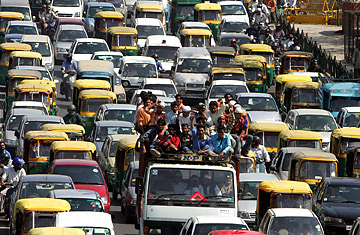
Heavy traffic in New Delhi, India, in March 2006.
Asian cities are noisy but few approach the sprawling mega-cities of South Asia — Bombay, Dhaka, Delhi — for sheer racket. It seems almost compulsory in south Asia to use your horn constantly. On a recent visit to Dhaka, Bangladesh, I noticed that the taxi driver I hired had worn smooth a spot on his steering wheel where his right thumb rested and pressed the horn incessantly as he weaved through traffic. In India and Bangladesh, turn signals and rear mirrors are for sissies. Drivers are responsible for what's ahead of them, not what's behind. Many studiously ignore vehicles not in their direct line of vision, meaning the horn is the only way to make your presence known. So drivers use it. Always.
In a traffic jam the results are spectacular: an almost continuous blast of horns, deep and tinny, near and far. The bass of a bus mixes with the thin shrieks of a motor scooter. Add in the noise of rasping truck brakes, the sweet tinkle of bicycles and rickshaws, the wailing Bollywood music pumped out by kids in their new cars, the reverberating bangs and cries of touts beating on the sides of buses for business, the siren of an ambulance vainly trying to push its way through the heaving mass and the general, constant growl of traffic and you have a wall of sound that would make Spector weep.
I'm not sure about where you live, but in Australia, where I'm from, it's bad form to sound your horn outside a hospital. It may even be illegal, but in any case obedient Australians would never dream of testing the authorities' patience. In Bangladesh a hospital seems to be an invitation to make as much noise as possible. Outside a hospital in Dhaka, waiting to interview an academic who was temporarily incapacitated, I noticed each driver in line to get into the small drop-off area was letting off steam by blasting their horns and shouting abuse at the people ahead of them. Conducting it all was a guard with a piercing metal whistle which never left his mouth. "Not the most peaceful place," agreed TIME's Dhaka stringer Haroon Habib when he arrived to help with the interview.
The cacophony in South Asian cities is no joke. A study in the Indian city of Ahmedabad in 2000 found that traffic noise regularly exceeded the tolerance level of 70 decibels and threatened many residents with permanent ear damage. An earlier study by India's Institute of Speech and Hearing showed that a quarter of Bangalore's 2000 police officers were suffering hearing loss because of noise pollution. The government has tightened up laws noise laws but fines are still tiny and India's booming economy is only adding to the sound level as hundreds of thousands of new cars and motor bikes hit the streets every year.
Some people are fighting back, taking noise cases to court and trying to create quiet neighborhoods in India's biggest cities. One of my favorite signs in Delhi greets you as you enter a middle-class suburb of hushed lanes and leafy parks. "Avoid car horns they cause mental disorder," it reads. Phil Spector, who once admitted to being "relatively insane" and has been charged with the murder of a 40-year-old actress, may sympathize.
